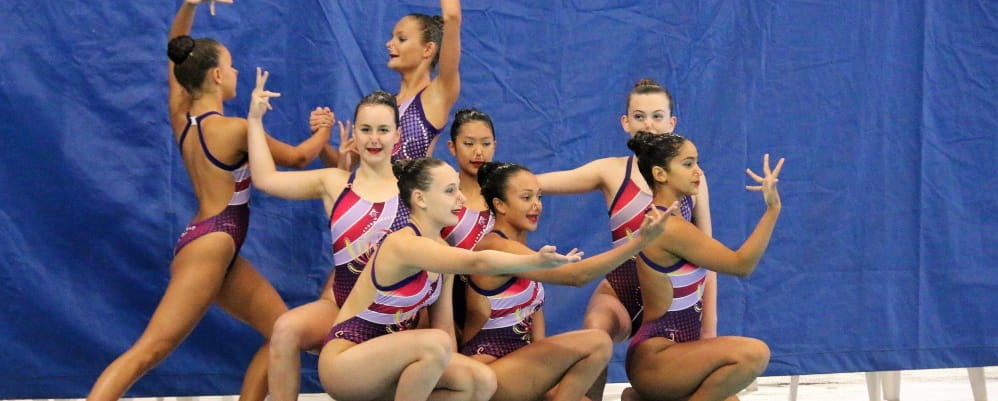
West Coast Splash's Synchronised Swimmers 13-15 age group pose as they practice their team routine performance.
History of Synchronised Swimming
The first cool fact we must take on board when delving deep into the history of synchronised swimming is that is no longer officially referred to as Synchronised Swimming at all! Since July 2007, the global governing body, FINA, has renamed it ‘Artistic Swimming’.
Artistic Swimming is a hybrid form of swimming, dance and gymnastics, consisting of swimmers performing a synchronised routine (either solo, duet, mixed duet, free team, free combination and highlight) of elaborate moves in the water, accompanied by music.
At the turn of the 20th century, synchronised swimming was known as water ballet. The first recorded competition was in 1891 in Berlin, Germany. Many swim clubs were formed around that time, and the sport simultaneously developed in Canada. As well as existing as a sport, it often constituted a popular addition to Music Hall evenings, in the larger variety theatres of London or Glasgow which were equipped with huge on-stage water tanks for the purpose.
In 1907, our very own Australian Annette Kellerman popularised the sport when she performed in a glass tank as an underwater ballerina - the first water ballet in a glass tank - in the New York Hippodrome. After experimenting with various diving actions and stunts in the water, Katherine Curtis started one of the first water ballet clubs at the University of Chicago, where the team began executing strokes, "tricks," and floating formations. On May 27, 1939, the first US synchronised swimming competition took place at Wright Junior College between Wright and the Chicago Teachers' College.
Esther Williams, a national Amateur Athletic Union (AAU) champion swimmer, popularised synchronised swimming during WWII and after, through (often elaborately staged) scenes in Hollywood films such as Bathing Beauty (1944), Million Dollar Mermaid (1952), and Jupiter's Darling (1955).
In the late 19th century, synchronised swimming was a male-only event; however, in the 20th century it became a women's sport, with men banned from many competitions. In the US, men were allowed to participate with women until 1941, when synchronised swimming became part of the AAU.
The AAU required men and women to compete separately, which resulted in a decline of male participants. In the 1940s and 1950s, Bert Hubbard and Donn Squire were among the top US male competitors.
In 2014, FINA announced that men would be allowed to compete at the 2015 World Aquatics Championships in two mixed-pair events. American Bill May and Frenchman Benoit Beaufils returned from decade-long retirements to represent their countries.
The 2016 European Aquatics Championships was the first time men were allowed to compete at the European Championships. While men are allowed in more events, they were still barred from competing in the 2016 Summer Olympic Games.
In the past decade, more men are becoming involved in the sport and a global biannual competition called Men's Cup has been steadily growing.
Rhythmic Swimming, Synchronised Swimming and now Artistic Swimming – any way you look at it, this stylish sport is still going strong!
Royal Life Saving has worked with Synchro WA to introduced Synchronised Swimming as part of some of our Swim and Survive programs and we look forward to seeing younger West Aussies give the sport a go in the future.
For more information on how you can get involved in our Swim and Survive program click below.
